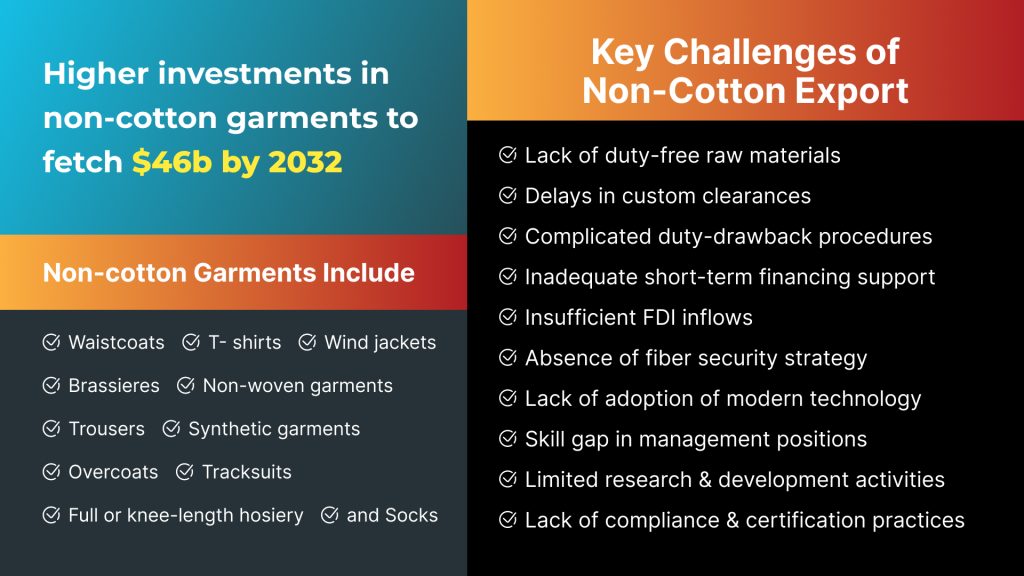
Investing in non-cotton garments is set to position Bangladesh as a leader in the global apparel business. This new direction aims to diversify away from the traditional reliance on cotton, a monumental $46 billion by 2032.
A significant $18 billion investment will enhance manufacturing capacities, promising a revolution in the garments industry in Bangladesh.
From the total investment requirement of $18 billion, it is planned that $4.6 billion will be allocated towards the manufacturing of fibre, filament, and yarn. Meanwhile, a substantial $9.2 billion is earmarked for the production of fabrics, with the remaining $4.2 billion intended for garment manufacturing processes.
Wazir Advisors Pvt Ltd, located in Jharkhand, India, conducted an analysis titled “Beyond Cotton: A Strategic Blueprint for Fibre Diversification in Bangladesh’s Apparel Industry.” This study was undertaken for the Bangladesh Garment Manufacturers and Exporters Association (BGMEA).
While discussing the report’s outcomes with journalists at the BGMEA headquarters in Dhaka, Varun Vaid, the business director of the consulting firm, emphasized that the investment plan includes a substantial upgrade in capacity. This will be achieved by adding 4.7 million spindles, introducing 14,000 modern knitting machines, deploying 31,000 new looms, and setting up half a million sewing machines.
Critical to this strategy is knocking into the increasing market for apparel made from artificial fabrics such as polyester. This is not only promises to raise Bangladesh’s garments export volumes but also to strengthen its standing as a top-tier garment supplier on the world stage.

The anticipated boom in non-cotton garments exports from Bangladesh reflects a keen understanding of market trends and consumer preferences.
With the global shift towards synthetic fibers, Bangladesh is gearing up to meet demand, promising a substantial economic uplift.
This strategic move is forecasted to create over a million jobs, marking a significant milestone in workforce development and economic enhancement.
Read another article: Best Garments Supplier in Bangladesh
The focus on non-cotton garments exports underscores a dynamic shift towards greater sustainability and resilience, essential qualities in today’s fast-evolving market prospect.
By aligning with global consumption patterns, Bangladesh is not just aiming to expand its market reach but also to future-proof its garments industry.
The Bangladesh Garment Manufacturers and Exporters Association (BGMEA) is setting ambitious goals to boost its presence in the international apparel market.
They aim to increase their market share from the current 7.87% to 12% by focusing on apparel made from synthetic fibers. According to Hassan, this shift towards non-cotton products could open up new markets and potentially lead to better pricing.
He also notes that climate change is influencing fashion trends, with a growing preference for synthetic fiber garments over traditional cotton. Despite the increased import of non-cotton fibers, now reaching $1.2 billion annually, the move towards diversification doesn’t mean moving away from cotton entirely.
Asif Ashraf, a BGMEA director, emphasizes the importance of local investment in this sector, suggesting it could both support exporters and generate more opportunities. Although the export volume of non-cotton apparel is currently lower than that of cotton apparel, it’s on a rapid rise.
This trend indicates a broadening interest among buyers in sourcing a diverse range of garments from Bangladesh. Despite cotton apparel’s dominance in certain categories – with t-shirts, jerseys, and woven trousers making up 63% of exports – the growing shift towards synthetic fibers highlights Bangladesh’s changing role in the global apparel industry.
Further, this initiative signals Bangladesh’s commitment to innovation and environmental stewardship in the apparel business in Bangladesh.
By broadening its manufacturing base, the country not only invites new opportunities but also addresses the pressing need for sustainability in fashion.
Bangladesh aims to harness its potential and set new benchmarks in the garments industry, ensuring its legacy as a global garment powerhouse continues to grow.

